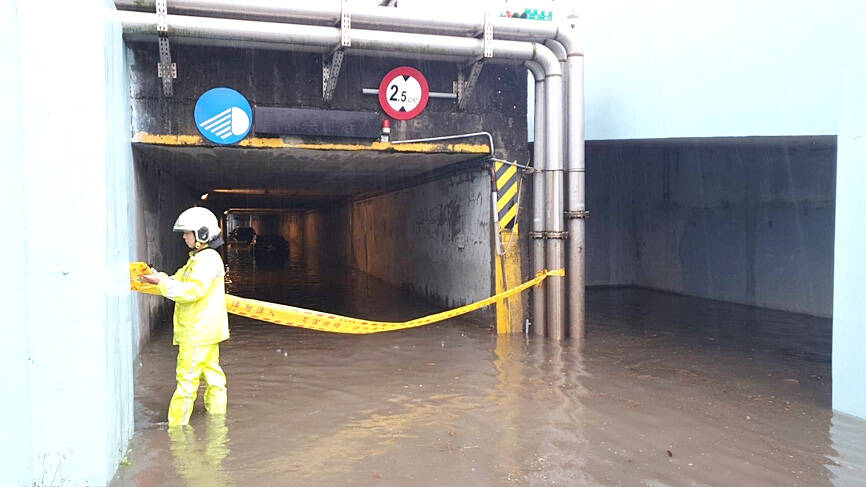Heavy downpours in northern Taiwan yesterday morning caused flooding, but did little to fill Shihmen Reservoir (石門水庫) in Taoyuan, with officials warning that the region could be facing a historic water shortage this year.
The Water Resources Agency’s Northern Region Water Resources Branch said the rain added a modest amount of water to the reservoir, which was at 24.56 percent capacity as of noon.
Since the rain fell mostly in the lower reaches of the reservoir’s catchment area, the office immediately contacted the Shihmen and Taoyuan management offices to suspend water supply farms in the region.

Photo copied by CNA
The retention rate at Shihmen Reservoir dropped to 24.2 percent on Wednesday, lower than levels in 2021, which were the lowest in a century.
Taoyuan Mayor Simon Chang (張善政) told reporters on Wednesday that the lower retention rate in 2021 was because the government withheld water from farms, which had left a lot of land fallow.
Peak irrigation has passed and the next major water usage period would not be until the heading stage at the end of next month, Chang said.
If the plum rains arrive by that time, the water shortage would be solved, but if it does not and water retention at the reservoir does not improve, farmers would have to start planning for the worst, he said.
Supply from the Bansin Water Treatment Plant had been switched to Feitsui Reservoir (翡翠水庫), while the Taoyuan Department of Economic Development is preparing 300 wells, eight water storage centers and 700 water towers to combat the water shortage, he said.
People should refrain from washing vehicles and windows, or conducting other activities that use large amounts of water, Chang said.
Meanwhile, the Taipei Feitsui Reservoir Administration said the greater Taipei area is unlikely to have a water shortage in the next three months after yesterday’s heavy downpour replenished the Feitsui Reservoir.
The catchment area had accumulated about 38.7mm of rainfall — or more than 10 million cubic meters — as of 9:50am yesterday, the agency said.
The amount is estimated to be equivalent to the storage capacity of the Sinshan Reservoir (新山水庫) in Keelung, it said.
The downpour had supplied the greater Taipei area with four days of water, it said.
The Feitsui Reservoir, the largest in Taiwan, was at 68 percent capacity, it added.
The Central Weather Administration said that the heaviest rainfall was at about 7am yesterday, with Taipei’s Nangang District (南港) and Wugu District (五股) in New Taipei City the most affected, each receiving about 70mm per hour, causing flooding in some areas.
Gene You (游景雲), director of National Taiwan University’s Hydrotech Research Institute, said that severe flooding was not a systemic problem, but was due to parts of the drainage system not coping.
The precipitation came before an annual review of drainage systems, usually conducted in May, You said.
City governments should consider establishing smaller retention areas in response to climate change, he said.
Asked if drainage systems should be checked earlier in the year, You said practicality must be considered, as while the schedule could be changed, drains would become cluttered with litter and trash before the rainy season.
Sudden, extreme downpours are increasingly regular and urban drainage systems should be upgraded, he said, citing Taipei’s system, which was designed to handle 78mm per hour, but should be increased to 88mm per hour.

Authorities have detained three former Taiwan Semiconductor Manufacturing Co (TMSC, 台積電) employees on suspicion of compromising classified technology used in making 2-nanometer chips, the Taiwan High Prosecutors’ Office said yesterday. Prosecutors are holding a former TSMC engineer surnamed Chen (陳) and two recently sacked TSMC engineers, including one person surnamed Wu (吳) in detention with restricted communication, following an investigation launched on July 25, a statement said. The announcement came a day after Nikkei Asia reported on the technology theft in an exclusive story, saying TSMC had fired two workers for contravening data rules on advanced chipmaking technology. Two-nanometer wafers are the most

NEW GEAR: On top of the new Tien Kung IV air defense missiles, the military is expected to place orders for a new combat vehicle next year for delivery in 2028 Mass production of Tien Kung IV (Sky Bow IV) missiles is expected to start next year, with plans to order 122 pods, the Ministry of National Defense’s (MND) latest list of regulated military material showed. The document said that the armed forces would obtain 46 pods of the air defense missiles next year and 76 pods the year after that. The Tien Kung IV is designed to intercept cruise missiles and ballistic missiles to an altitude of 70km, compared with the 60km maximum altitude achieved by the Missile Segment Enhancement variant of PAC-3 systems. A defense source said yesterday that the number of

A bipartisan group of US representatives have introduced a draft US-Taiwan Defense Innovation Partnership bill, aimed at accelerating defense technology collaboration between Taiwan and the US in response to ongoing aggression by the Chinese Communist Party (CCP). The bill was introduced by US representatives Zach Nunn and Jill Tokuda, with US House Select Committee on the Chinese Communist Party Chairman John Moolenaar and US Representative Ashley Hinson joining as original cosponsors, a news release issued by Tokuda’s office on Thursday said. The draft bill “directs the US Department of Defense to work directly with Taiwan’s Ministry of National Defense through their respective

Tsunami waves were possible in three areas of Kamchatka in Russia’s Far East, the Russian Ministry for Emergency Services said yesterday after a magnitude 7.0 earthquake hit the nearby Kuril Islands. “The expected wave heights are low, but you must still move away from the shore,” the ministry said on the Telegram messaging app, after the latest seismic activity in the area. However, the Pacific Tsunami Warning System in Hawaii said there was no tsunami warning after the quake. The Russian tsunami alert was later canceled. Overnight, the Krasheninnikov volcano in Kamchatka erupted for the first time in 600 years, Russia’s RIA